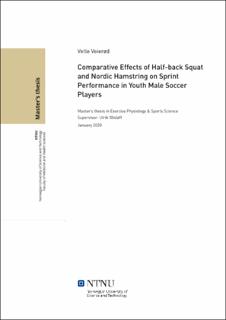| dc.description.abstract | Abstract
Background: Sprint performance is related to game-decisive moments in soccer, and the number of sprints is related to success. Maximal strength training (MST) is considered an effective method to improve sprint performance. Biomechanics and EMG analysis show that the quadriceps and gluteals are crucial in the acceleration phase, whereas eccentric hamstring strength is crucial at higher speeds. The half-back squat (HBS) exercise mainly targets the quadriceps and gluteals, and the Nordic hamstring (NH) targets the hamstrings eccentrically.
Aim: We aimed to study and compare the effects of HBS and NH on sprint performance at different sprint distances in youth male soccer players after 9 weeks of MST.
Method: Twenty-three youth male soccer players (15.2 ± 1.3 years, 62.9 ± 9.8 kg, 176.7 ± 8.3 cm) were randomly allocated to either a Half-back squat (HBS) group (n = 12) or an NH group (n = 11). An age-matched soccer team was used as a control group (n = 12). HBS and NH groups performed 9 weeks of two weekly maximal strength training (MST) sessions in their allocated exercise. All players tested 40 m straight-line sprint (split times: 5, 10, 20, 30, and 40 m), change of direction (COD) sprint, and countermovement jump test (CMJ). The HBS group tested HBS 1RM, and NH group tested NH peak force (PF). COVID-19 outbreak: Norway went into lockdown March 12th which forced us to cancel the post-tests. Baseline tests were used to study and compare the relationship between HBS 1RM (kg·bw−0.67) and sprint performance, and NH PF (N·bw−0.67) and sprint performance.
Results: HBS 1RM (kg·bw−0.67) correlated better with greater sprint distances compared to shorter (i.e. 0-5 m: r = -0.69, p = 0.60, 10-30 m: r = -0.93 < 0.001.) The same was evident for NH PF (N·bw−0.67) (i.e. 0-5 m: r = -0.49, p = 0.176, 20-40 m: r = -0.86, p = 0.003). HBS 1RM (kg·bw−0.67) was higher correlated with sprint times on all sprint distances and COD compared to NH PF (N·bw−0.67).
Conclusion: Correlations indicate that HBS and NH may be more effective in improving sprint times at greater sprint distances compared to shorter (i.e. after 10 m), and that HBS may be superior to improve overall performance in both straight-line and COD sprinting.
Keywords: Half-back squat, Nordic hamstring, soccer, sprint, maximal strength, peak force | |
